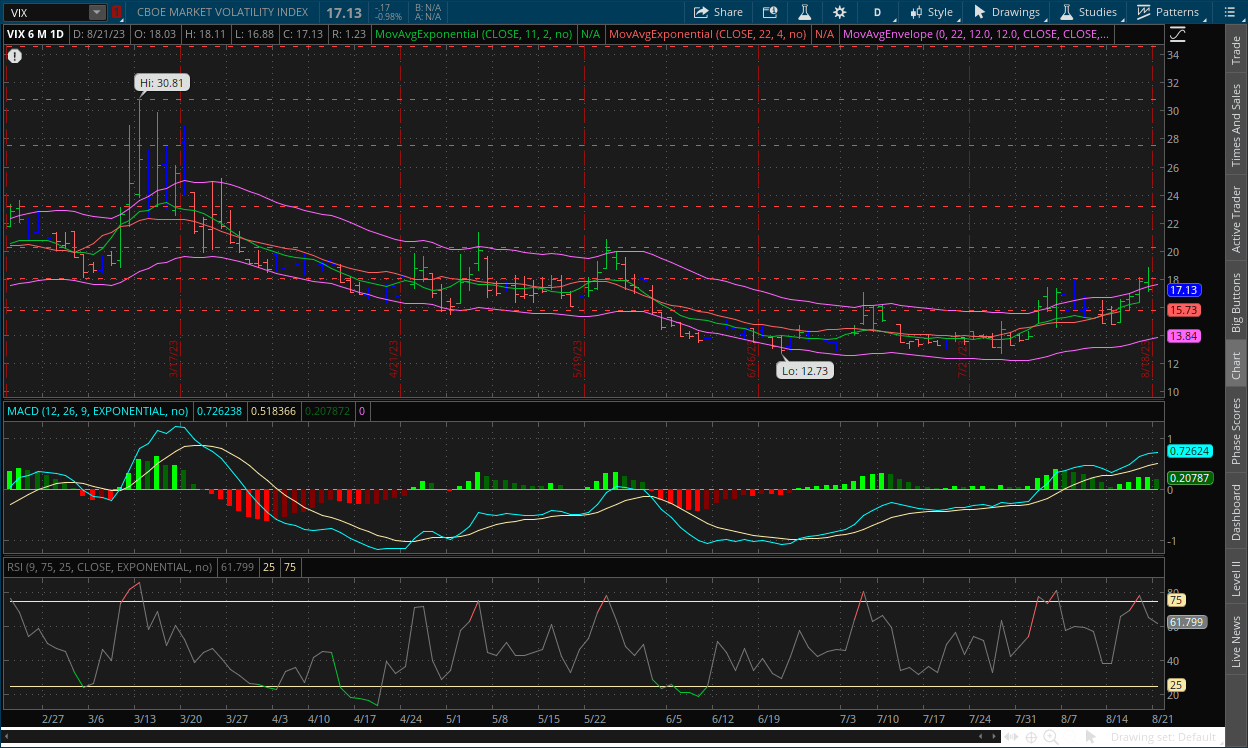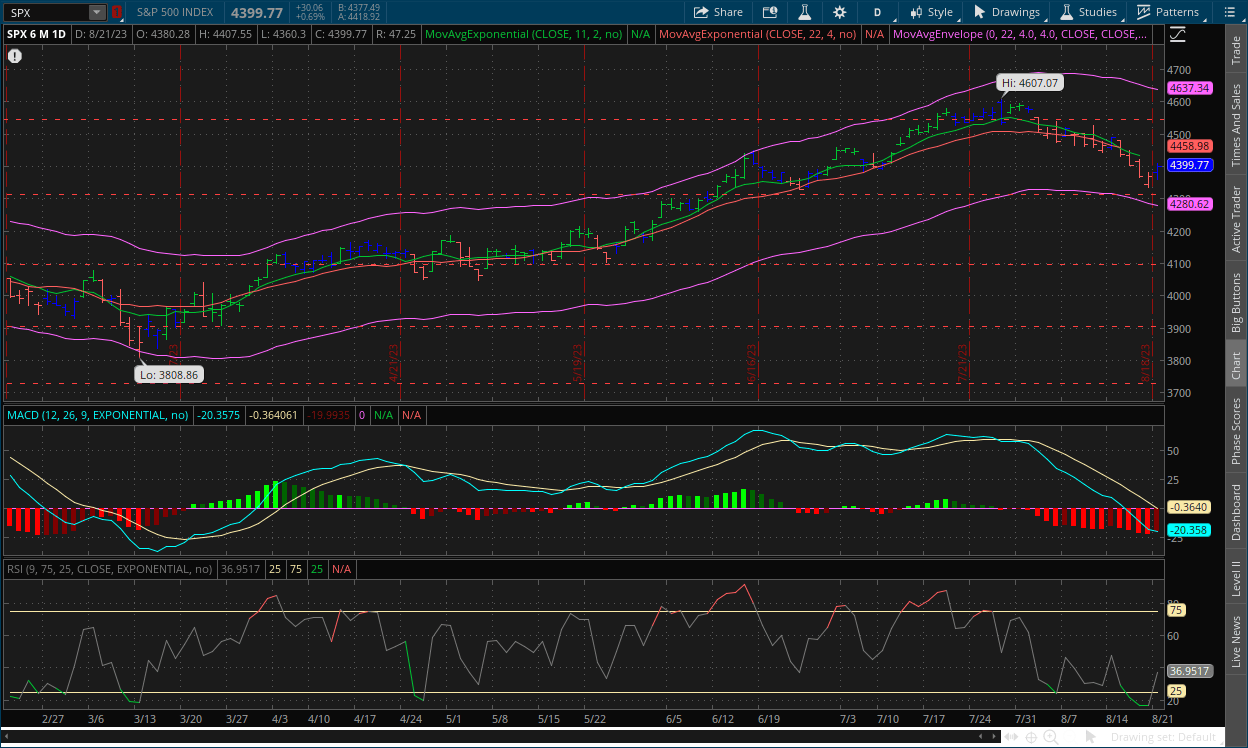The Take Five Report: 8/22/23
I
Markets:
I-I
Global Market Recap:
United States:
- S&P: +0.69%
- Dow: -0.11%
- Nasdaq: +1.56%
- Russell 2k: -0.18%
Major U.S. indexes would open in the green. A sell off began shortly after the open and brought the S&P, and more so the Dow into negative territory while the Nasdaq managed to stay relatively steady in comparison. Around noon, markets began rallying back through the close. The Dow and Russell 2k would finish marginally down, while the S&P and Nasdaq logged solid gains led by Magnificent Seven stocks.
Asia:
- Shanghai: +0.88%
- Hong Kong: +0.95%
- Japan: +0.92%
- India: +0.01%
Asian equities rebounded in this morning’s session, with Hong Kong pacing the region in gains and snapping its seven-session losing streak. Most markets in the region were up significantly, even with bond yields rising to levels not seen in over a decade.
Europe:
- UK: -0.06%
- Germany: +0.16%
- France: +0.47%
- Italy: +0.81%
European markets as a whole ended up having a rather lackluster day following a strong open from the major markets within the region. Global sentiment continued to weigh on European equities, as poor economic data from China, concerns over global interest rates, and this week’s Jackson Hole event, in which Fed Chair Jerome Powell will be speaking at, were the main cautionary points.
I-II
U.S. Sectors Snapshot:
- Communication Services: +0.80%
- Consumer Discretionary: +1.15%
- Consumer Staples: -0.64%
- Energy: -0.62%
- Financials: -0.09%
- Health Care: +0.09%
- Industrials: -0.14%
- Info Tech: +2.26%
- Materials: +0.02%
- Real Estate: -0.88%
- Utilities: -0.60%
II
Technicals:
II-I
Volatility Index: (VIX)
Monday Recap:
The VIX would open the session a notch below the $18.07 resistance level at $18.03. It would work its way to a high slightly above the opening price early on, up to $18.11 before beginning to slide. Prices would reach a low of $16.88 but manage to close above that mark at $17.13, declining -0.98% on the day.
Daily Chart:

Strength would move in favor of the VIX bears, after four straight sessions of moving in favor of the VIX bulls as they try to gain ground that was lost over the last few sessions. Inertia would change very little and is still favoring upward momentum by a decent margin.
Prices would pull back after breaking above the $18.07 resistance level in Friday’s session. We said that this was a possible case, but the resistance level was minor compared to others, and was less likely to deter prices than other levels. However, this point did in fact hold the VIX bulls following a false breakout. We also said at the next point of resistance, whether it be at $18.07 or $20 approximately, that we would likely end up getting some form of pullback, and then a consolidation period. The pullback is what we’re seeing now but as for consolidation, that may be a tough sell because of the Jackson Hole catalyst on Friday that we overlooked in our previous report. This even essentially lays out the Fed’s roadmap for the following year, and Powell’s rhetoric will need to be closely monitored. Markets will react depending on how it is.
II-II
S&P 500: (SPX)
Monday Recap:
The S&P would open Monday’s session slightly higher than Friday’s, opening at $4,380 and reaching a low of $4,360 within the first half of the day. Prices would climb to a high of $4,407, breaking above the $4,400 resistance level before closing a notch below that mark at $4,399.
Daily Chart:

Strength would move in favor of the bulls, snapping the four-session winning streak the bears had. However, the MACD-H still remains well below the centerline, as the bulls have a lot of ground to make up before they can say they have control once again. Inertia would remain in favor of the bears and change very little, if at all.
Following the breakout below the $4,450 minor and $4,400 major support levels on Wednesday and Thursday, prices have started to pull back which we thought would likely be the case. However, we remain by our standpoint that the breakout below $4,450 was a true breakout, and that prices will likely pull back to that point but consolidate once that mark is met again (similar to the VIX’s price action.) But as said above, consolidation may be a tough sell due to Jackson Hole on Friday. A pull back and consolidation to round out the month would also fall in line with our earlier prediction this year that markets would begin to decline, and flatten towards the end of August, which would be the case if we were to get some type of consolidation now.
III
Fundamentals:
III-I
Headlines:
1.) Bloomberg: Treasury yields hit highest since November of 2007 on elevated rate fears
2.) Bloomberg: Half a million US jobs at risk of vanishing in payroll revision
3.) Market Insider: Americans need to spend 43% of their income to afford a home as mortgage rates sure to 23 year high
4.) Financial Times: Global spread of birth rate decline makes problem more, not less urgent
III-II
BRICS Summit Begins in Johannesburg:
Background:
The BRICS nations are gathering together in Johannesburg, South Africa for a two day summit aimed at reinforcing their alliance. The alliance includes Brazil, Russia, India, China, and South Africa. BRICS’ leaders will all be in attendance, minus Russian president Vladimir Putin who is wanted for war crimes by the International Criminal Court (ICC), who South Africa is a part of, and would legally be obligated to arrest him over his indictment. Instead, Foreign Minister Sergei Lavrorv will take his place, but Putin will still video call into the event. As we know, indictments don’t mean much, and are more political statements than anything else, especially when it comes to one party’s opposition.
Main Topic of Discussion - Expansion:
The alliance over the years has often been divided on their vision of how they should be on the global stage. The topic of expansion is no different. China and Russia are the most in favor of this objective. Russia is looking to make more global allies after becoming diplomatically isolated, and economically restricted following the invasion of Ukraine, and rightfully so to be fair. China is looking to build a broader coalition of developing countries to extend influence, and reinforce their efforts to compete more broadly with the US on the global stage. “The traditional global governing system has become dysfunctional, deficient and missing action,” the Chinese ambassador to South Africa said at a briefing last week, adding that the BRICS grouping was “increasingly becoming a staunch force in defending international justice.”
Brazil and South Africa are relatively skeptical of the idea of expansion on the terms that it would “dilute their influence” in the alliance and embellish China’s claim to lead the developing world. India, however, is much more riled. The expansion plan, but more specifically the political stance that Beijing has taken against the west has India’s president, Narendra Modi skeptical. Professor Harsh Pant, an international relations expert at the Observer Research Foundation in Delhi said, “India is looking to ensure that this platform doesn’t drift off into being an openly anti-western platform, and there is a danger of that with both Russia and China having a certain agenda. India, and least of all Modi, have no interest in shaping India’s foreign policy in an anti-western direction. BRICS was conceived as a geoeconomic platform but is drifting into a geopolitical role and India is not likely to be comfortable with that.” With India’s opposition to any new members of the alliance without strict safeguards and of course its concerns that Xi will pack the group with anti-western allies, there likely won’t be a consensus of immediate expansion.
Officials say that more than forty countries have expressed interest in joining the alliance, with twenty-three formally filing for admittance. Among the interested nations include Saudi Arabia, Iran, Egypt, and Indonesia.
De-Dollarization:
The summit will also discuss an initiative by the aligning nations to use their local currencies in trade among themselves rather than the US dollar, but analysts and diplomats, and even South Africa has said that the use of a common currency (i.e. a BRICS currency) isn’t a topic of discussion during the summit. “This local currency expansion will principally focus on the renminbi, supported by China’s assertive internationalization agenda,” analysts at South Africa’s Standard Bank said.
De-Dollarization is a topic that has been on the alliance’s agenda for some time now. India recently made an agreement (that we discussed in detail) between themselves and the UAE to only use local currencies in trade, setting a precedent for other nations to do the same. We’ve seen BRICS members continuously allocating away from the dollar, and more specifically unloading US Treasuries from their balance sheets, with China the other day reducing their holdings to a now 14 year low. Simultaneously, we’ve seen these nations loading up on gold reserves, with China again, leading the way. We’ve theorized that this is likely for the, in our opinion due to the Big Cycle’s forces, inevitable BRICS currency that will ultimately be pegged to gold, creating a much safer, and stable storehold of wealth. However, we will admit that this is a few years away at minimum. The summit should provide a fair insight into the alliance’s future plans. But we don’t believe anything earth shattering will come out of it, although we will keep a watchful eye. Xi Jinping, Putin, and Modi will be the leaders we will most pay attention to.
IV
Market Psychology & Final Thoughts:
Futures are still edging up as we head towards the open. Yesterday’s rally was propelled by Magnificent Seven stocks, which isn’t surprising to us. Today will likely be the same case, as hype surrounding Nvidia’s earnings release tomorrow has propelled the chip designer to new highs, and they’re taking the overall market along with them. Markets are likely to continue rallying today as the pullback continues, and we’ll likely see some consolidation in the coming days if the S&P and VIX hit their nearest points of resistance and support respectively, before Jackson Hole on Friday. As always we hope you found this helpful, learned a thing or two, and have a great day.